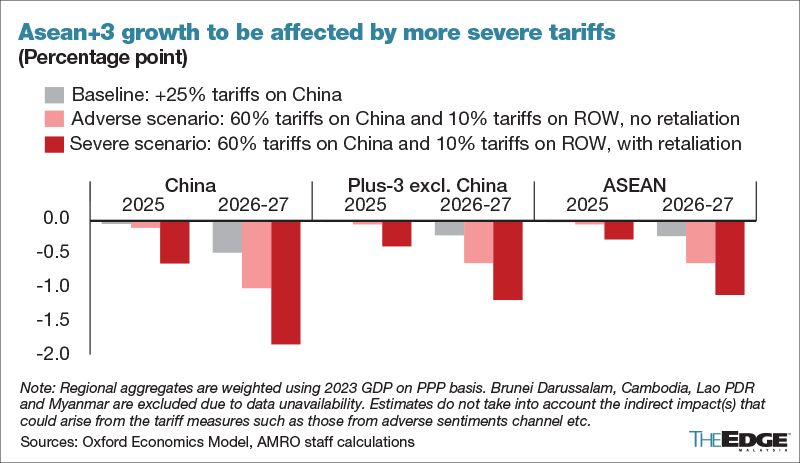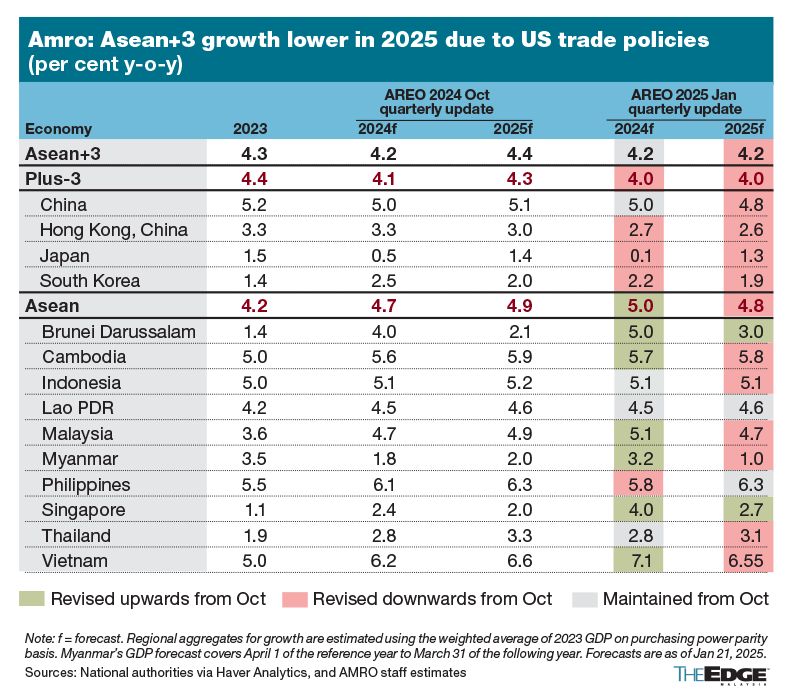
A port in Shenzhen, China. For Asean, AMRO has reduced its growth estimate to 4.8% from 4.9% for 2025, assuming that the US will impose higher tariffs on Chinese goods in the second half of the year.
KUALA LUMPUR (Jan 21): A tariff war with the US will cut into economic growth of a trading bloc of Southeast Asian nations, China, Japan and South Korea, according to a regional macroeconomic surveillance organisation.
Under the worst-case scenario, growth of the 13-country bloc will be shaved off up to two percentage points by 2026-2027 from retaliation against the US’ planned import tariffs on China and other countries, according to the Asean+3 Macroeconomic Research Office (AMRO).
“This would represent the slowest regional growth since the Asian financial crisis, excluding the pandemic years of 2020-2022,” said Allen Ng, the head and principal economist of AMRO, during a briefing on the January 2025 update on the Asean+3 Regional Economic Outlook.
For now, AMRO has lowered its full-year economic growth forecast for the Asean+3 region to 4.2% for 2025, from the previous 4.4% in its October 2024 update, in view of the challenging external environment stemming from US trade protectionism policies.
For the 10-member Association of Southeast Asian Nations, or Asean, growth estimates have also been reduced to 4.8% from 4.9%.
The downgrades assume that the US will impose higher tariffs on Chinese goods in the second half of 2025, Ng noted.
Still, Asean economies are expected to demonstrate resilience, benefiting from robust domestic demand and export growth that would partly cushion impact of the increased trade tensions dampening external demand and disrupting global supply chains, according to AMRO.
There are also other risks, AMRO said, flagging US monetary and fiscal policies heightening uncertainty for Asean economies.
"This divergence in interest rate paths between the US and Asean central banks could tighten financial conditions in the region, complicating monetary policy," said AMRO chief economist Khor Hoe Ee at the same briefing.
The most recent US economic data suggested a persistently strong labour market and firmer core inflation, fuelling concerns about sustained inflationary pressures and raised expectations for prolonged tight monetary conditions.
That could pose pressure on regional foreign exchange driven by interest rate differentials between the US and the bloc, Khor added.
- Trump officials say letter to Harvard sent by mistake — report
- Sinonomics: Americans Can’t Win from Trump’s Trade War
- US open to recognising Crimea as Russian in Ukraine deal, Bloomberg reports
- Busy US earnings week confronts market grappling with tariff fallout
- Anwar: Malaysia needs quantum leap to become developed nation


